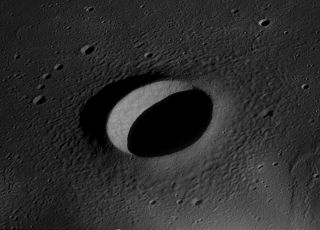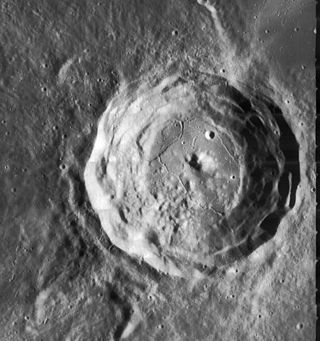
Birt is a lunar impact crater located in the eastern half of the Mare Nubium and west of the Rupes Recta. It was named after British selenographer William R. Birt.

Brayley is a lunar impact crater located in the southwest part of the Mare Imbrium. It was named after British geographer Edward W. Brayley in 1935. It has a circular rim and a low rise in the center. There are no notable craters overlapping the rim or interior. The sinuous rille Rima Brayley passes to the north of Brayley.

Seeliger is a relatively small lunar impact crater that lies near the southeastern edge of Sinus Medii. It was named after the German astronomer Hugo von Seeliger. This is a circular, cup-shaped feature that has not been appreciably worn by impact erosion. To the southeast is a rille named the Rima Réaumur, following a line to the northwest. In the north is the 110-km-long Rima Oppolzer, which divides the mare where Seeliger is situated from the remainder of the Sinus Medii.

Cauchy is a small lunar impact crater on the eastern Mare Tranquillitatis. It was named after French mathematician Augustin-Louis Cauchy. It is circular and symmetric, with a small interior floor at the midpoint of the sloping inner walls. Due to the high albedo of this bowl-shaped formation, it is particularly prominent at full Moon.

Bode is a small crater located near the central region of the Moon, to the northwest of the joined craters Pallas and Murchison. It lies on a region of raised surface between the Mare Vaporum to the northeast, Sinus Aestuum to the west, and Sinus Medii to the southeast. The crater was named after German astronomer Johann Elert Bode.

Gay-Lussac is a lunar impact crater located to the north of the prominent crater Copernicus, in the southern foothills of the Montes Carpatus range. The rim of the crater is slightly distorted, although generally circular. The inner floor is flat but rough, with no central peak. There are a pair of small craterlet depressions in the middle instead of a central peak. The associated crater Gay-Lussac A is nearly joined to the southeast rim.

Suess is a small lunar impact crater on the Oceanus Procellarum. It is a circular, cup-shaped feature with a higher albedo than the surroundings. The closest significant crater is Reiner, about 150 kilometers to the west-northwest. The lunar mare that surrounds Suess is marked by the rays radiating from the crater Kepler to the east-northeast.

Ariadaeus is a small, bowl-shaped lunar impact crater on the western shores of Mare Tranquillitatis. It lies to the north of the crater Dionysius, and to the west-southwest of Arago. The crater is joined along the northeast rim by the slightly smaller Ariadaeus A, and the two form a double-crater. Its diameter is 10.4 km.

Cardanus is a lunar impact crater that is located in the western part of the Moon, in the western part of the Oceanus Procellarum. Due to its location the crater appears very oval because of foreshortening, and it is viewed almost from the side.

Delisle is a small lunar impact crater in the western part of the Mare Imbrium. It was named after French astronomer Joseph-Nicolas Delisle. It lies to the north of the crater Diophantus, and just to the northwest of the ridge designated Mons Delisle. Between Delisle and Diophantus is a sinuous rille named Rima Diophantus, with a diameter of 150 km. To the northeast is another rille designated Rima Delisle, named after this crater.

Flammarion is a lunar impact crater on the south edge of Sinus Medii. Its diameter is 76 km. It is named after the French astronomer Camille Flammarion. It is located between the crater Mösting to the northwest and Herschel to the southeast. The bowl-shaped Mösting A intersects the western rim of Flammarion.

Réaumur is the remains of a lunar impact crater located on the southern edge of Sinus Medii. Its diameter is 51 km. It was named after the 18th century French scientist René de Réaumur. It shares an eroded rim with the similar crater Oppolzer to the northwest. It lies to the northwest of the large walled plain Hipparchus, and east of Flammarion. To the south is Gyldén, and farther to the south-southwest is Ptolemaeus.

Calippus is a small lunar impact crater that is located on the eastern edge of the rugged Montes Caucasus mountain range in the northern part of the Moon. It was named after Greek astronomer Callippus of Cyzicus. It lies to the southwest of the crater remnant Alexander, to the northwest of the Mare Serenitatis.

Whewell is a lunar impact crater that lies on a stretch of lava-resurfaced terrain to the west of Mare Tranquillitatis. Its diameter is 13 km. It was named after the 19th-century English philosopher and naturalist, William Whewell. It is located to the east of the disintegrated crater Tempel and north-northwest of D'Arrest. To the east is Cayley, a slightly larger but very similar formation. To the North lies the Rima Ariadaeus, which is a linear rille that is 300 kilometers long and was formed when a section of the Moon's crust sank down between two parallel fault lines, producing a graben. Further north again, lies the 90 km wide crater Julius Caesar.

Conon is a small but prominent lunar impact crater that lies in the eastern foothills of the Montes Apenninus mountain range. The crater is named for the Greek astronomer Conon of Samos. Just to the west of Conon is the long mountainous ridge Mons Bradley. The nearest craters possessing an eponym are Galen, about 70 kilometres (43 mi) to the east, and Aratus, about the same distance to the northeast.

Cayley is a small lunar impact crater that is located in a lava-flooded region to the west of Mare Tranquillitatis. It was named after the 19th-century English mathematician Arthur Cayley. It lies to the northwest of the smaller crater De Morgan and the larger D'Arrest. West and slightly north of Cayley is Whewell, a crater of about the same dimensions. To the north is a linear rille designated Rima Ariadaeus, which follows a course to the east-southeast.

Yangelʹ is a small lunar impact crater that is located in the irregular terrain to the north of the Mare Vaporum. Its diameter is 8 km. It was named after Soviet rocketry scientist Mikhail Kuzmich Yangelʹ in 1973. This crater was formerly designated Manilius F.

G. Bond is a small lunar impact crater to the south of the Lacus Somniorum, a small lunar mare in the northeast part of the Moon's near side. It was named after the American astronomer George Phillips Bond. It lies to the east of the larger crater Posidonius, and to the south of the flooded crater remnant Hall. The crater is situated in a rugged section of terrain to the northwest of the Montes Taurus mountain region.

Mons Bradley is a lunar mountain massif in the Montes Apenninus range, along the eastern edge of the Mare Imbrium. It is located to the west of the crater Conon. To the west of this peak is the Rima Bradley rille.

Danjon is a lunar impact crater on the far side of the Moon. It lies less than a crater diameter to the east-southeast of the larger crater Langemak. To the east-northeast of Danjon is the crater Perepelkin, and due south lies the walled plain Fermi.





















